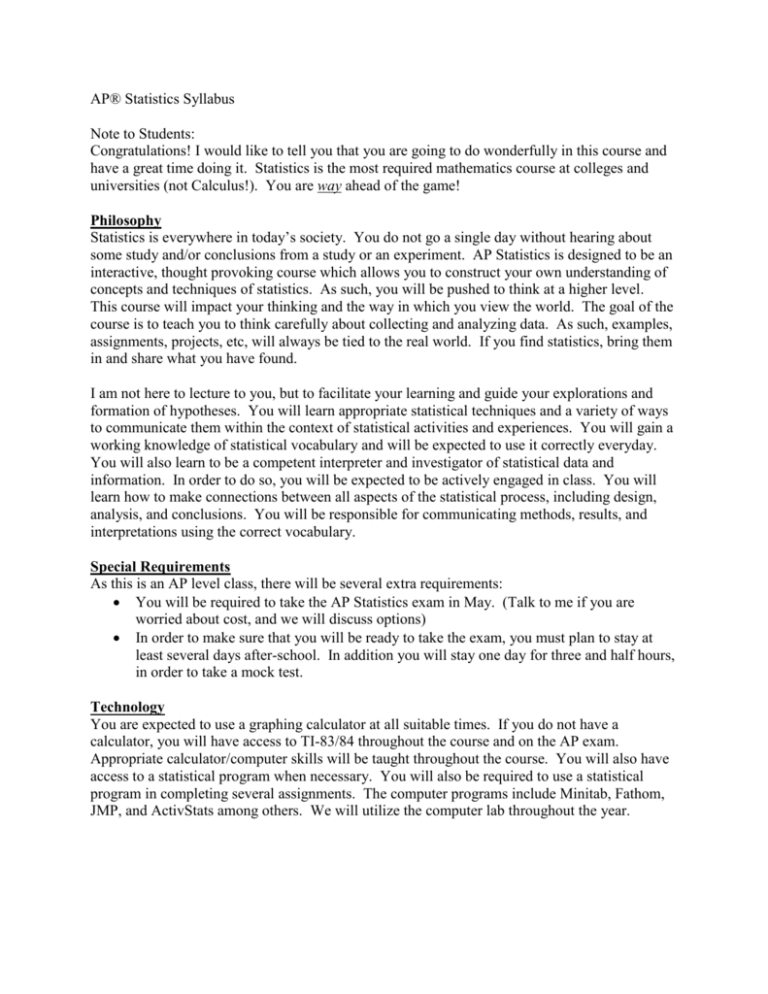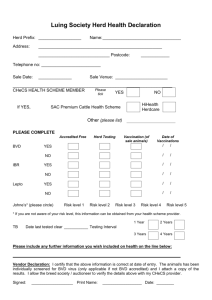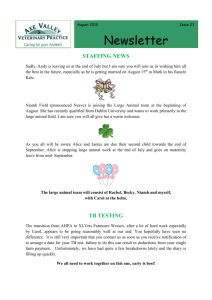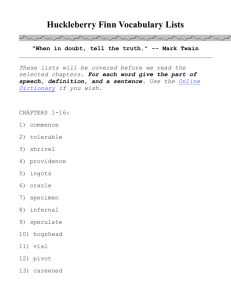
AP® Statistics Syllabus
Note to Students:
Congratulations! I would like to tell you that you are going to do wonderfully in this course and
have a great time doing it. Statistics is the most required mathematics course at colleges and
universities (not Calculus!). You are way ahead of the game!
Philosophy
Statistics is everywhere in today’s society. You do not go a single day without hearing about
some study and/or conclusions from a study or an experiment. AP Statistics is designed to be an
interactive, thought provoking course which allows you to construct your own understanding of
concepts and techniques of statistics. As such, you will be pushed to think at a higher level.
This course will impact your thinking and the way in which you view the world. The goal of the
course is to teach you to think carefully about collecting and analyzing data. As such, examples,
assignments, projects, etc, will always be tied to the real world. If you find statistics, bring them
in and share what you have found.
I am not here to lecture to you, but to facilitate your learning and guide your explorations and
formation of hypotheses. You will learn appropriate statistical techniques and a variety of ways
to communicate them within the context of statistical activities and experiences. You will gain a
working knowledge of statistical vocabulary and will be expected to use it correctly everyday.
You will also learn to be a competent interpreter and investigator of statistical data and
information. In order to do so, you will be expected to be actively engaged in class. You will
learn how to make connections between all aspects of the statistical process, including design,
analysis, and conclusions. You will be responsible for communicating methods, results, and
interpretations using the correct vocabulary.
Special Requirements
As this is an AP level class, there will be several extra requirements:
You will be required to take the AP Statistics exam in May. (Talk to me if you are
worried about cost, and we will discuss options)
In order to make sure that you will be ready to take the exam, you must plan to stay at
least several days after-school. In addition you will stay one day for three and half hours,
in order to take a mock test.
Technology
You are expected to use a graphing calculator at all suitable times. If you do not have a
calculator, you will have access to TI-83/84 throughout the course and on the AP exam.
Appropriate calculator/computer skills will be taught throughout the course. You will also have
access to a statistical program when necessary. You will also be required to use a statistical
program in completing several assignments. The computer programs include Minitab, Fathom,
JMP, and ActivStats among others. We will utilize the computer lab throughout the year.
Course Plan
The primary textbook will be Stats: Modeling the world by Bock, Velleman, and De Veaux
(BVD) (see resource list for full bibliographic citation)
*note: the units are numbered the way that they are numbered in the primary textbook, BVD.
You will be expected to read the chapters before class, so that we can devote our time to
discussion, investigations, and activities with less time lecturing.
Introduction:
Time Frame: Week 1
BVD Chapters: 1-2
Topics Covered:
What is Statistics and why do we care?
What is data?
Unit III: Collecting Data (sampling and experimentation)
BVD Chapters: 11-13
Time Frame: Weeks 2-6
Topics covered:
Designing surveys via various methods
Bias in surveys
Randomization and representative samples
Experimental design:
o Control
o Random assignment of treatment
o Replication
o Placebo & blinding
o Blocking and matched pairs
o Confounding and lurking variables
o Statistically significant difference (introduction)
Observational studies
Unit I: Exploring and Understanding Data
BVD Chapters: 3-6
Time Frame: Week 7-12
Topics covered:
Describing and displaying categorical data
Introductory discussion of independence
Describing and displaying quantitative data
Summary statistics for quantitative data
Outliers
The normal distribution
The effect of linear transformations to data sets on summary statistics
o To include but not limited to: boxplots, dotplots, stem plots, back-to-back stem
plots, histograms, frequency plots, and parallel boxplots.
Unit II: Regression
BVD Chapters: 7-10
Time Frame: Weeks 13-18
Topics covered:
Displaying and describing scatterplots
Analyzing two-variable quantitative data:
o Correlation and the coefficient of determination
o Least-squares regression
o Slope and y-intercept
o Residuals and residual plots
o Outliers and influential points
Transformations to achieve linearity
Unit IV: Probability
BVD Chapters: 14-17
Time Frame: Weeks 19-24
Topics covered:
Basic probability principles including complement, independence and mutually exclusive
Simulating probability scenarios
Addition, multiplication and conditional probability rules
Random variables:
o Expected value and standard deviation
o Rules for transforming and combining random variables
Binomial and geometric distributions
Sampling distributions for means and proportions
Unit V: Inference for Proportions
BVD Chapters: 18-22
Time Frame: Weeks 25-30
Topics covered:
Confidence intervals for one and two proportions
Hypothesis testing for one and two proportions
Type I and II errors and power
Unit VI: Inference for Means
BVD Chapters: 23-25
Time Frame: Weeks 30-31
Topics covered:
Confidence intervals for one and two means (with t)
Hypothesis testing for one and two means (with t)
Confidence intervals and hypothesis testing for matched pairs means (with t)
Unit VII: Inference for Counts and Slope
BVD Chapters: 26-27
Time Frame: Weeks 32-33
Topics covered:
Chi-square goodness-of-fit
Chi-square for homogeneity and for independence
Confidence interval for slope
Hypothesis testing for slope
Review for the Exam
Time Frame: Week 34
Review for the AP exam
Cumulative Project
Time Frame: Weeks 35-38
Cumulative projects
Assignments
All daily assignments are given from the questions at the end of each chapter. Questions will be
assigned based on the need of the overall class. There will also be daily tickets to leave. A ticket
to leave will consist of a question or two in regards to the topic being covered that day, used to
make sure that learning objectives are being met.
Assessments
There will be a major assessment at the end of each unit. All major assessments will be of a
form similar to the AP exam. This consists of AP-like multiple choice questions and AP-like
free-response questions. Released exams will be used throughout the year in order to prepare
students for the AP exam.
Investigations
There will be investigations throughout the year, at least one biweekly. Investigations are
designed so that you may construct your own knowledge. Participation is necessary and
expected.
Unit Projects
Each unit will be concluded with a project. The purpose of the unit projects are to articulate your
discovery of statistical knowledge and present your knowledge in a way that demonstrates
mastery. The projects will generally involve a written portion and a presentation.
Cumulative Project
The main purpose of cumulative course project is for you to demonstrate that you are able to
develop and conduct a statistical study, and then use the data collected to make sound
connections and judgments between the design and the results of the experiment. You will also
be expected to analyze the collected data and make inferences. You will be expected to
complete a written portion in which you will explain your methods and justify your decisions.
You will also present your findings to your fellow classmates.
Resources
The following resource list is meant to be a guideline of resources being used. It is not meant to
limit the resources used.
“Agile Mind.” Agile Mind. Agile Mind, Inc, and The University of Texas at Austin. 28 Feb
2007 <http://sheldon.agilemind.com>.
Bock, David E., and Richard D. DeVeaux. Stats: Modeling the World. Boston:
Pearson/Addison-Wesley, 2007. (And all ancillary materials)
College Board. AP Statistics Free Response Problems. New Jersey: College Board, 2006.
Levine-Wissing, Robin and David Thiel. AP Statistics: (REA), New 3rd Edition. New Jersey:
Research and Education Association, 2007.
Other resource materials used come from newspapers, select journals, AP workshops and
institutes and the World Wide Web. Students often use data sets they have collected.
Peck, Roxy, Chris Olsen and Jay Devore. Introduction to Statistics and Data Analysis. Belmont:
Brooks/Cole—Thomson Learning, 2004. (And all ancillary materials)
Rossman, Allan J., Beth L. Chance and J. Barr von Oehsen. Workshop Statistics; Discovery with
Data and the Graphing Calculator. Emeryville: Key Curriculum Publishing, 2002.
Scheaffer, Richard L., Ann Watkins, Mrudulla Gnanadesikan and Jeffrey A. Witmer. Activity
Based Statistics. New York: Springer-Verlag, 1996.
Watkins, Ann, Richard L, Scheaffer, and George W. Cobb. Statistics in Action: Understanding a
World of Data. 1st ed.. Emeryville: Key Curriculum Press, 2007. (And all ancillary
materials)
Yates, Daniel S., David S. Moore and Daren S. Starnes. The Practice of Statistics. New York:
W. H. Freeman, 2003. (And all ancillary materials)






